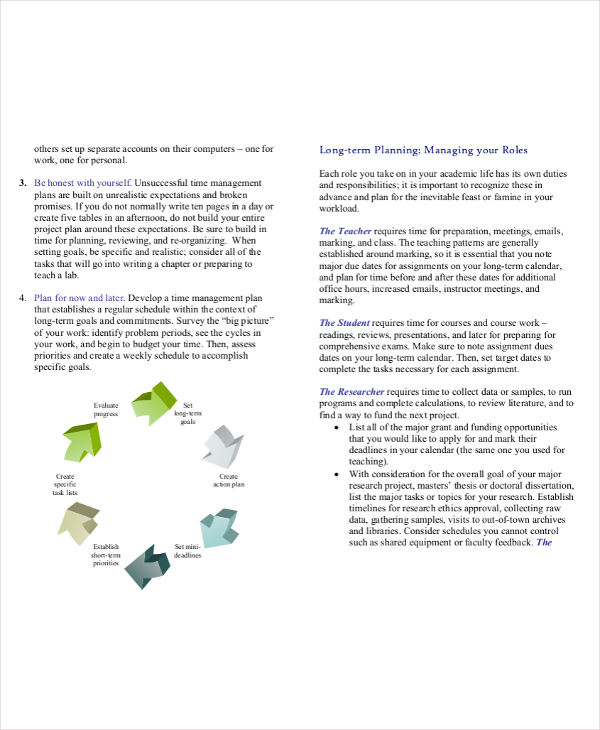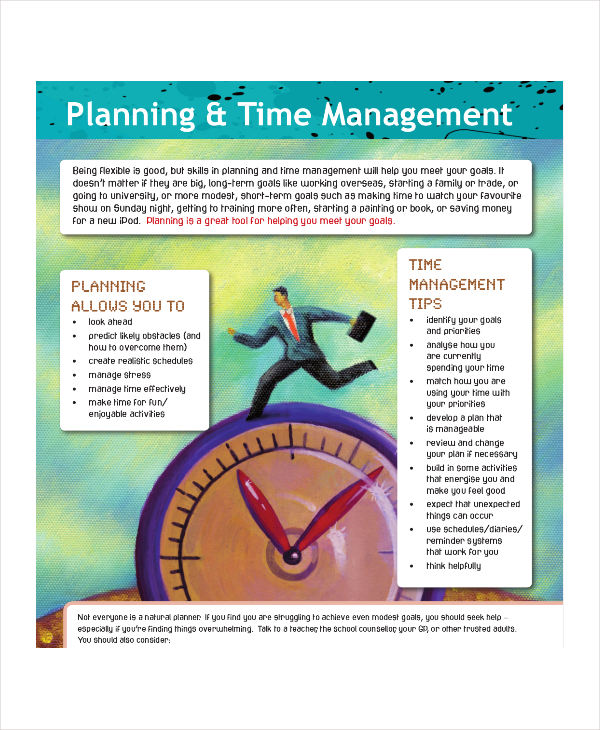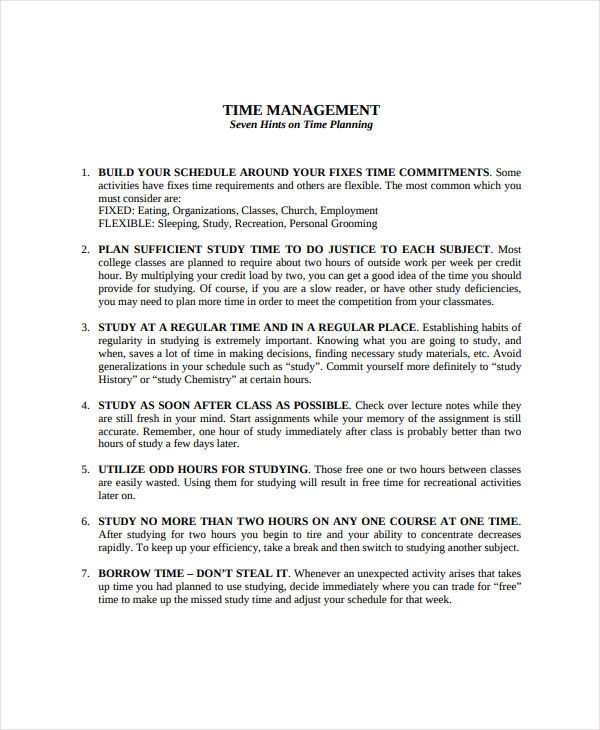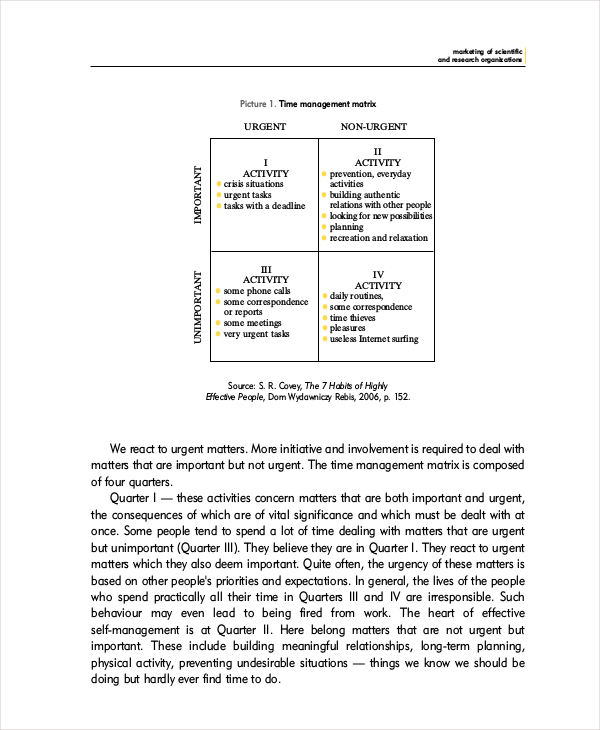Time Management Plan
As humans, we always seem to find ourselves completely occupied doing our own thing. But sometimes, starting the day tremendously early and ending it incredibly late can take a toll in our physical and mental health. This is why good time management is a key ingredient towards success. With proper scheduling, you can reach your professional and personal goals accordingly.

The Importance of Time Management
When you’re running late for a meeting with your boss, and find yourself scrambling for your phone and wallet, only to realize you’re left with a mere 15 seconds before the last bus for the morning leaves you behind; would you still think proper general scheduling isn’t all that important?
Time Management For Graduate Students

Time Management Planning

Time Management for Small Business

Good time management is crucial in so many different levels. Think about it: how many times have you stressed out over an unfinished project with numerous deadlines piling up by the hour? Every glance at the clock keeps the adrenaline pumping, forcing your entire body to go into maximum overdrive. Sometimes, there’s just not enough time in the day to complete a task or reach a goal. If you don’t have the motivation to pull yourself together, then all the time management plans and scheduling charts aren’t going to do you any favors.
First things first, always look at the bigger picture. Imagine how much you could get done in a day if you knew how to manage your time properly. Keep in mind that time is limited. We can’t buy time, and it won’t be given to us whenever we need it the most. It won’t slow down for you, nor will it stop on your command. With only 24 hours in a day, you need to make every hour, every minute, and every second count. You may also see annual plan examples and samples.
Organization Time Management Plan

Time Management Action Plan

Another reason why time management is a vital part of life is because it allows you to accomplish your duties and responsibilities with less effort required. If you don’t agree with this, then try looking back at all the times you’ve caught yourself cramming at the last minute just to get something done before it is due. You may also see action plan examples.
Anything done in a rush could look sloppy and unpolished, especially if a person fails to pay attention to every single detail. When you learn to take control of the time granted to you, you soon learn how to improve your ability to focus as well. This way, you’ll breeze through each task as swiftly as you could say ‘hallelujah!’ You may also check out project plan examples.
But the greatest advantage of being time-conscious is that you’d have enough time to kick back and relax knowing that you’ve already accomplished your job effectively. There’s nothing like taking an afternoon nap without anything running through your mind. Between jobs, school works, errands, family responsibilities, and what not, most of us just need to take a short breather before all the chaos consume us. You may also like work plan examples & samples.
Having good time management skills gives you that extra time to do stuff for your own sanity and well-being. Not only will this reduce a significant amount of stress, but it also gives you enough allowance to deal with any sudden changes and emergencies that may come your way.
Student Time Management Plan

Effective Time Management Plan

Time Management Techniques to Help You Out
Admit it. Most of us find it difficult to manage our time, despite our will to do so. Fortunately, there are various time management techniques that might work out for you.
1. The Pomodoro Technique
The Pomodoro Technique is one of the most popular time management hacks practiced across various industries by writers, lawyers, developers, and students. This technique centers on hyper-focus, which forces you to power through distractions that may slow you down. And the best part is, you can take frequent breaks in between each task to clear your mind from any work-related thoughts. You may also see risk plan examples & samples.
In this technique, you need to time yourself for about twenty-five minutes. This requires you to work procrastination-free for twenty-five minutes straight. And when your time is up, you can take a short break to let your mind drift away from anything that can cause you to stress out. This trains your brain to concentrate for shorter periods of time, while still being able to accomplish tasks before the given deadline. You may also like implementation plan examples & samples.
When faced with large tasks that are impossible to complete within the given time frame, you can break them down into smaller parts to make it more doable using the Pomodoro technique. It’s a cyclical system that demands you to work in shorter sprints in order to ensure productivity. The breaks granted in between each assignment will also give you enough motivation to push through. You may also check out event plan examples & samples.
2. Time Blocking
You know how when you look at the calendar and your mind automatically reminds you about the pilates class that runs from 7 in the morning until 8:30 am? This allows you to prioritize the given event, pay full attention to it, and make sure you’re mentally (and physically) prepared for it.
Time blocking is a common time management tactic that allows you to organize duties and responsibilities into thoroughly scheduled events in either an agenda calendar or schedule sheet. This technique can help keep you on track while steering clear of any distractions, procrastination tendencies, and unproductive multitasking instances. Time blocking is generally done a day before a given task must be executed to leave you a significant amount time to prepare beforehand.
Ultimately, the secret to successful time blocking is to know how and when you work best in a week. For instance, Mondays are the worst days to get things done. Since your mind and body are conditioned to work slower than usual, this day is the perfect time to schedule low-demand tasks such as planning and organizing. This way, you can gradually adapt to the transition from the weekend, and get yourself ready for the rest of the week. You might be interested in business plan examples.
3. Time Management Matrix
Among the techniques that were mentioned, the time management matrix has to be the most complicated one of them all.
To understand how Dr. Stephen Covey’s matrix model works, let us look into the summary of each quadrant:
- Quadrant I – Tasks that belong to this category include those with important deadlines and a high sense of urgency. Anything that could cause major consequences if they aren’t attended to immediately need to stay in this box. You may also see risk management examples & samples.
- Quadrant II – As for tasks that are important but not urgent, make sure to list them down here. These tasks are often the recipe for future success. Though these tasks aren’t as significant as those found in the first quadrant, you still need to keep at the of your head. If you find yourself neglecting them, they could end up as your urgent and important tasks. You may also like sales plan examples.
- Quadrant III – There are cases where an assignment might be urgent, but not entirely important to the overall goal. Emails, calls, meetings, and reports all belong to this quadrant.
- Quadrant IV – For tasks that are neither important nor urgent, jot down them down in this section. These tasks yield no value whatsoever to your end goal, so it’s better to keep them at the very bottom of your priority list for better execution. You may also check out job plan examples & samples.
Counseling Time Management Plan

Draft Time Management Plan

How to Schedule Your Time Effectively
For individuals who are always on-the-go, or simply suffer from a pretty bad case of procrastination and poor management skills, creating a proper time management plan is beneficial in many ways. While using a weekly planner would do, it would be better to create an in-depth plan in the following manner:
1. Identify the Time Available.
Start by establishing the time frame available for you to accomplish your work.
Say for example, students often have breaks in between classes, and a few hours to do homework right after school. Should you have any other commitments set within this available time, make sure they work around your schedule. You can also allocate weekends for in-demand workloads that require a great amount of time and effort to accomplish. You may also see transition plan examples & samples.
2. Make a List of Tasks.
Creating a checklists of tasks will make it easier to assess for the next step. Since we’re all guilty of having the memory of a gold fish during particular instances, it’s always good a list handy just in case we end up forgetting something extremely important.
3. Schedule in Order of Priority.
Once you have your list of tasks ready, you must then schedule high-priority and urgent activities first. Arranged these items according to the time of day you are most productive. For instance, most people feel more energized and motivated to get things done in the morning, while others function more effectively during the evening. Tasks that demand a great amount of focus and energy should be allotted at whatever time works best for you. You may also like assessment plan examples & samples.
4. Set an Allowance.
Remember, no matter how careful you are, not everything is bound to go as planned. Shortcomings and other sudden conflicts are nearly impossible to avoid, which is why it’s important to adjust your time schedule in order to cater to any possible disruptions. Though these interruption will be difficult to foresee, you need to ensure that your schedule remains as flexible as possible. You may also check out audit plan examples & samples.
5. Analyze each Activity.
The last step of the process may seem like the easiest, but it’s actually the most critical. This is the part where you need to examine each activity carefully before coming up with your final plan. Study each task and decide whether or not what you have entered are completely necessary to your goal. You need to verify if the schedule you have created maximizes the time granted to you to accomplish a job before its respective deadline. You might be interested in quality plan examples & samples.
Bad time management can lead to a high level of stress and anxiety; it makes the whole process even more daunting to deliver, and it stops you from doing the things that you actually enjoy. For this reason, proper scheduling has become an essential part of our day-to-day lives. Time that is managed correctly can lower your stress levels, enhance your ability to focus, and ensure a better sense of achievement due to the number of projects that have been completed before the said deadline. It’s a continuous cycle that can lead you to a healthier and happier lifestyle. You may also see plan examples.


